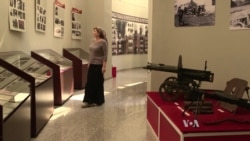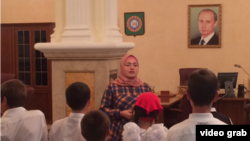Salam Shaipov tears up when asked about Russia's wars against Chechnya's independence.
“Our best guys, the most honest guys, they all died during the first Chechen war,” he said, referring to the war launched in 1994 by Russia's then-president Boris Yeltsin.
Looking at one of the few remaining buildings in the Chechen capital of Grozny still scarred by the fighting, Shaipov, who lives nearby, says the abandoned apartment building, with broken windows and graffiti, used to house mostly Russians but, his neighbors also included Armenians, Azerbaijanis and Jews.
Shaipov told VOA they all got along well before the fighting.
“We were leading a normal life. I don't know who needed this war and where it came from,” he said. “Ordinary people have no idea why the first war was launched. I have no idea why it was required. And there was absolute lawlessness during the second war."
A lack of understanding about the wars in Chechnya is not surprising.
In Grozny, very little evidence remains of the two destructive wars Russia fought there, from 1994 to 1996 and from 1999 to 2009, to quash independence and Islamist movements.
But the image of the man who launched the second war that helped bring him to power, Russian President Vladimir Putin, is plastered throughout the Chechen capital and a main thoroughfare is named after him.
Photographs of a younger Putin are prominently featured on Grozny’s government buildings alongside those of the loyal leaders he installed: Akhmad Kadyrov and his son, Ramzan Kadyrov, who has ruled Chechnya since 2007.
Ramzan Kadyrov received 98 percent of the vote earlier this month in the republic's first direct election for its leader since 2004.
Inside the National Museum of the Chechen Republic are displays ranging from plates with painted images of the Kadyrovs to a rug said to have belonged to resistance leader Imam Shamil, whom the Russians in 1859 forced to surrender.
Waiting to assess history
But, there is not a single mention of the two Chechen wars.
“Not so much time passed since those events,” explained Tamara Elbuzdukaeva, the museum's deputy director. “Shall we collect the remains of the bombs?” she asks rhetorically. “We have picked up piles of them in our back yards.”
“As we were taught, one should wait for a while to make comments on history,” adds Elbuzdukaeva. “These are recent events and the people who have not yet separated with their pain are still alive.”
The number of civilians killed in the two conflicts range from the tens to the hundreds of thousands.
She notes it took decades for Russia to come to terms with Soviet leader Joseph Stalin's deportation of Chechens and other minorities in the 1940s. The museum has an exhibit dedicated to the victims of the Stalin-era deportation of Chechens, exiled en masse from their land after Moscow accused them of siding with Nazi Germany.
Inthe Akhmad Kadyrov museum, there are large exhibits dedicated to the life of Ramzan Kadyrov’s father and to the heroes of Russia and World War Two.
A tour guide points toward a roped-off office scene under a portrait of Putin, explaining to a group of school children that Kadyrov signed important documents at these desks.
But the tour skips past a corner of photographs on the Chechen wars that show some of the devastation and political leaders who were involved. The small display gives little explanation of the conflicts or of the Kadyrovs’ role as rebels who switched sides in the second war to fight alongside the Russian military.
‘Horrible memories’
"It is not mentioned about the two Chechen wars because we actually try not to remember about that,” tour guide Luiza Khatueva tells VOA, “because these are horrible memories."
”We are focused on a different topic here,” she says, “and it seems to me it would be a bit out of place because we mostly show here how our republic has flourished."
The Chechen capital was nearly leveled during the fighting but was completely rebuilt, mostly with money from Moscow under Putin’s patronage. A small complex of modern skyscrapers called “Grozny City” imitates a larger one in the Russian capital named “Moscow City.” New bicycle lanes pass by a shopping mall, manicured parks, and the grand Akhmad Kadyrov Mosque that opened in 2008.
Insurgent attacks are rare, though rights activists fear Ramzan Kadyrov’s heavy hand will breed more, as Kadyrov-controlled militias still appear frequently in the streets.
Museum deputy director Elbuzdukaeva says they are step by step collecting materials on the Chechen wars.
“It is not known exactly how many people died, how many refugees there were, how badly was the national economy and the oil complex damaged, as well as all the other fields like education, healthcare," she adds. "Our recovery from these wounds will take a very long period of time."
She hopes one day to have a permanent exhibit on the wars, with Kadyrov’s support.
“I hope that after the elections the head of the republic, with a new inspiration, will deal with this issue,” she says, “taking into consideration that the results of his activities are quite visible.”
Elbuzdukaeva says Chechens do not wish to dwell on the past, but that they should know their history in order not to repeat the same mistakes.








